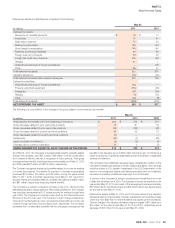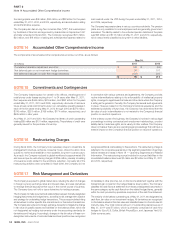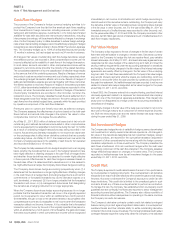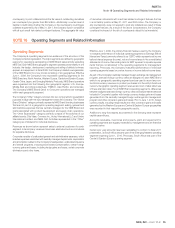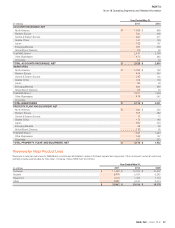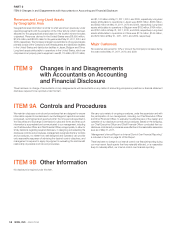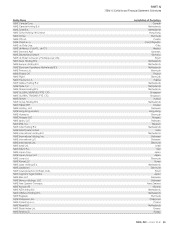Nike 2011 Annual Report Download - page 55
Download and view the complete annual report
Please find page 55 of the 2011 Nike annual report below. You can navigate through the pages in the report by either clicking on the pages listed below, or by using the keyword search tool below to find specific information within the annual report.
55NIKE,INC.-Form10-K
PARTII
Note18Operating Segments and Related Information
counterparty, to post collateral should the fair value of outstanding derivatives
per counterparty be greater than $50million. Additionally, a certain levelof
decline in credit rating of either the Company or the counterparty could trigger
collateral requirements. As of May31,2011, the Company was in compliance
with all such credit risk related contingent features. The aggregate fair value
of derivative instruments with credit risk related contingent features that are
in a net liability position at May31,2011 was $160million. The Company, or
any counterparty, were not required to post any collateral as a result of these
contingent features. As a result of the above considerations, the Company
considers the impact of the risk of counterparty default to be immaterial.
NOTE18 Operating Segments and Related Information
Operating Segments
The Company’s operating segments are evidence of the structure of the
Company’s internal organization. The major segments are defi ned by geographic
regions for operations participating in NIKE Brand sales activity excluding
NIKEGolf. Each NIKE Brand geographic segment operates predominantly in one
industry: the design, development, marketing and selling of athletic footwear,
apparel, and equipment. In fi scal 2009, the Company initiated a reorganization
of the NIKE Brand into a new model consisting of six geographies.Effective
June1,2009, the Company’s new reportable operating segments for the
NIKE Brand are: North America, Western Europe, Central and Eastern Europe,
Greater China, Japan, and Emerging Markets. Previously, NIKEBrand operations
were organized into the following four geographic regions: U.S., Europe,
Middle East and Africa (collectively, “EMEA”), Asia Pacifi c, and Americas.
TheCompany’s NIKE Brand Direct to Consumer operations are managed
within each geographic segment.
The Company’s “Other” category is broken into two components for presentation
purposes to align with the way management views the Company. The “Global
Brand Divisions” category primarily represents NIKE Brand licensing businesses
that are not part of a geographic operating segment, selling, general and
administrative expenses that are centrally managed for the NIKE Brand and
costs associated with product development and supply chain operations.
The “Other Businesses” category primarily consists of theactivities of our
affi liate brands; Cole Haan, ConverseInc., Hurley InternationalLLC and Umbro
International Limited; and NIKE Golf. Activities represented in the “Other”
category are immaterial for individual disclosure.
Revenues as shown below represent sales to external customers for each
segment.Intercompany revenues have been eliminated and are immaterial
for separate disclosure.
Corporate consists of unallocated general and administrative expenses, which
includes expenses associated with centrally managed departments, depreciation
and amortization related to the Company’s headquarters, unallocated insurance
and benefi t programs, including stock-based compensation, certain foreign
currency gains and losses, including hedge gains and losses, certain corporate
eliminations and other items.
Effective June1,2009, the primary fi nancial measure used by the Company
to evaluate performance of individual operating segments is Earnings Before
Interest and Taxes (commonly referred to as “EBIT”) which represents net income
before interest expense (income), net and income taxes in the consolidated
statements of income. Reconciling items for EBIT represent corporate expense
items that are not allocated to the operating segments for management
reporting. Previously, the Company evaluated performance of individual
operating segments based on pre-tax income or income before income taxes.
As part of the Company’s centrally managed foreign exchange risk management
program, standard foreign currency rates are assigned to each NIKE Brand
entity in our geographic operating segments and are used to record any non-
functional currency revenues or product purchases into the entity’s functional
currency. Geographic operating segment revenues and cost of sales refl ect use
of these standard rates. For all NIKE Brand operating segments, differences
between assigned standard foreign currency rates and actual market rates are
included in Corporate together with foreign currency hedge gains and losses
generated from the centrally managed foreign exchange risk management
program and other conversion gains and losses. Prior to June1,2010, foreign
currency results, including hedge results and other conversion gains and losses
generated by the Western Europe and Central& Eastern Europe geographies
were recorded in their respective geographic results.
Additions to long-lived assets as presented in the following table represent
capital expenditures.
Accounts receivable, inventories and property, plant and equipment for
operating segments are regularly reviewed by management and are therefore
provided below.
Certain prior year amounts have been reclassifi ed to conform to fi scal 2011
presentation, as South Africa became part of the Emerging Markets operating
segment beginning June1,2010. Previously, South Africa was part of the
Central& Eastern Europe operating segment.






